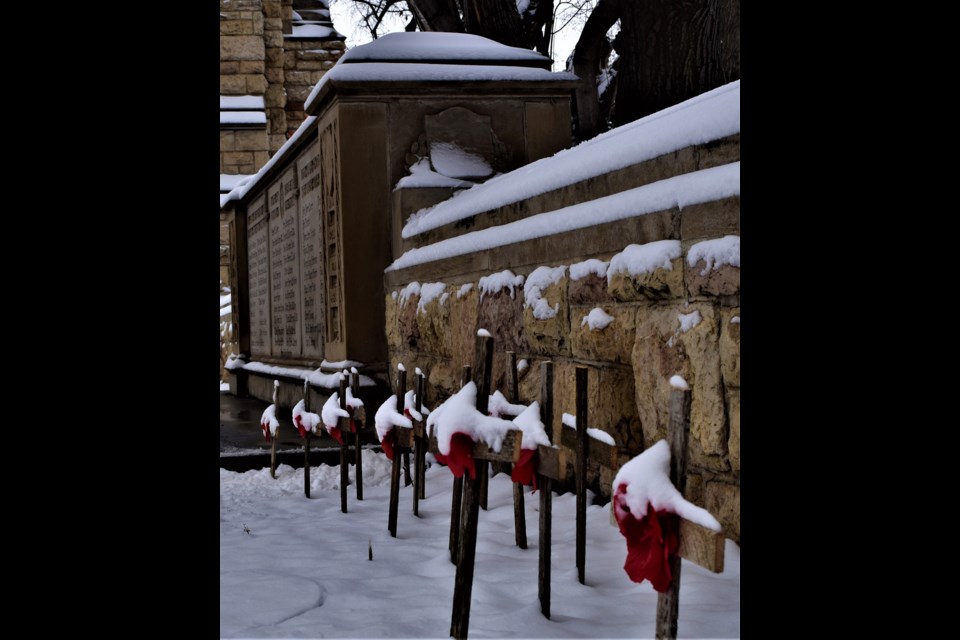SASKATOON — University of Saskatchewan president Peter Stoicheff led the learning institution’s Remembrance Day ceremony on Thursday by laying wreaths at the Memorial Gates, a tradition that started 93 years ago to honour those who served — past and present — and made the ultimate sacrifice to defend the freedoms that all Canadians are enjoying.
Stoicheff said USask has a long history in terms of military service.
“I’m very grateful that every year we have this opportunity to gather to do something important together. [USask] has a long, very proud, and tradition and history of military service by generations of faculty, staff, students, and alumni leading back now more than a century.”
“For the past 93 years, every year on this day we have placed wreaths here in memory of those who have made the ultimate sacrifice for the country and to pay tribute together to all who have served and continue to serve in times of war and times of peace.”
The Memorial Gates were erected in 1927 and dedicated on May 3, 1928, to the alumni of the university who gave up their lives in the First World War (1914-198). Sixty-nine names are etched to a wall near the gates, which was the location of the main entrance of the university from its original plans. The main entry point changed during the 1960s.
Stoicheff added that more than 2,500 from USask enlisted in World War II including 202 individuals who perished in the line of battle. USask faculty, students, staff, and alumni also served in the Korean War and was part of an international force in Afghanistan as well as joining in numerous peacekeeping and humanitarian missions around the world.
Numerous memorials are also scattered around the campus — like the new memorial bench near the original residences dedicated 100 years later and honour ribbons in the Peter McKinnon building corridors — to remind everyone of those who served and continue to serve to fight injustice and tyranny.
“The university's memorials are a permanent reminder of our close Campus Â鶹´«Ã½ion to Canadian military service and history,” added Stoicheff.
He then mentioned four of the numerous USask alumni, staff, students, and faculty that fought in the first and second world wars. They were Lt. Burton Elliot, Captain Donald MacArthur Cowie, Gordon Nelson Patterson, and Dr. Margaret Brooke.
Elliot studied in the early years of USask and was teaching at a rural school near Saskatoon before enlisting to fight in the First World War. He suffered serious shrapnel wounds and died in battle. Captain Donald MacArthur Cowie graduated at USask in 1937, volunteered to serve in World War II, and was killed during the D-Day landings at Juno Beach on Sept. 18, 1944.
Dr. Margaret Brooke studied at USask before and after serving in World War II where he served as a Navy nurse. She was named an Order of the British Empire member for her courage and gallantry in saving the life of a fellow nurse. She went back to Canada and served for 20 years reaching the rank of Lt. Commander before returning to USask to earn her doctorate degree.
She worked in USask’s Department of Geological Sciences and before she died in 2016, reaching the age of 100, a Royal Canadian Navy Ship (HMCS) was named after her.
Gordon Nelson Patterson DFM CD was born in Woodrow, Sask., in 1919, and joined the Royal Air Force around 1938, after being a merchant seaman. In May of 1940, he was involved in a raid over the Maastricht Bridges in Belgium, which resulted in the First Two Victoria Crosses of the War being awarded, and two other decorations, a Distinguished Flying Cross and Patterson being awarded the Distinguished Flying Medal, as he was an Aircraftman Ist at the time. After destroying several German fighters, Patterson's plane was riddled with holes and he was ordered by the pilot to bail out. Dad did so and was captured. After being released from prisoner of war camp, he was transferred to the Royal Canadian Air Force at the rank of Warrant Officer and he finished the war with the rank of Pilot Officer. Upon his return to Canada he enrolled in the University of Saskatchewan and achieved his engineering degree in engineering/physics. Upon completion of his degree he re-enrolled in the RCAF at the rank of Flying Officer. After a long career with the RCAF, he retired at the rank of Squadron Leader, and came to work at the Faculty of Physics at the University of Saskatchewan in 1966. He worked at the University and was heavily involved with the RASC Saskatoon branch, until forced, due to poor health, to retire. (This information on Gordon Nelson Patterson DFM CD was provided by his son.)




